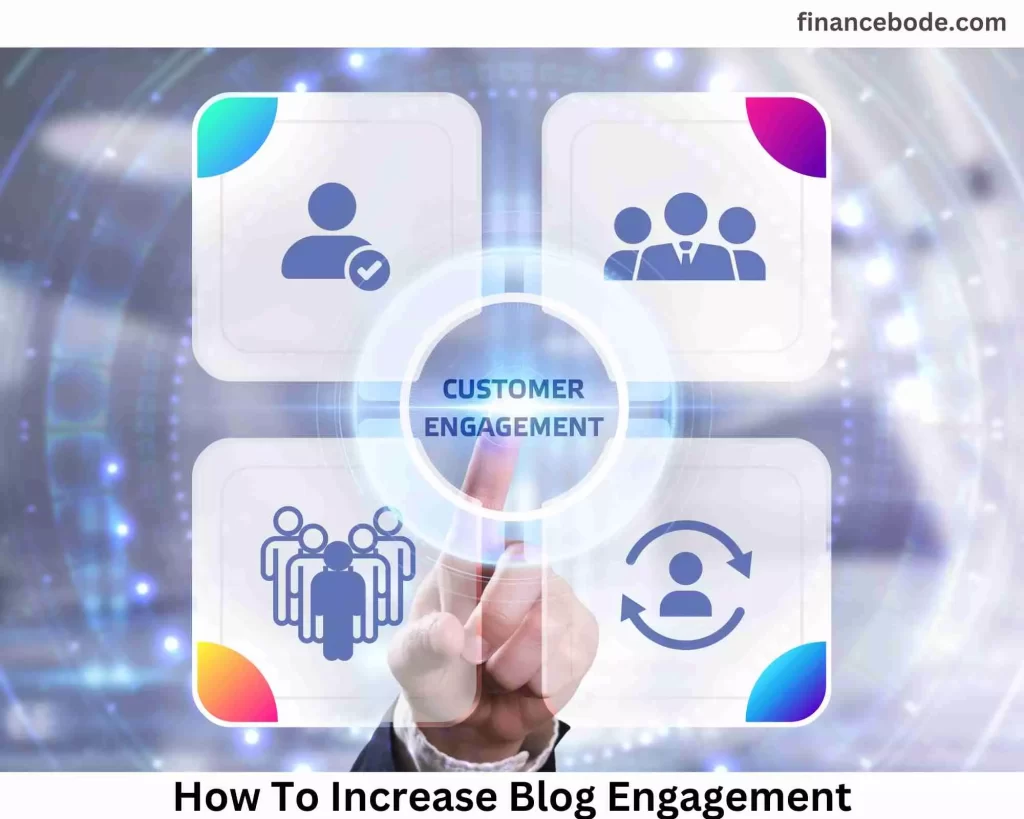Are you looking for how to increase your blog engagement? Then you’re at the right spot!
In this post, I will share 8 useful strategies to teach you how to increase your blog engagement.
You may have put so much work into producing fantastic content and generating traffic for your new site, but it still needs to get the engagement it deserves.
Blog engagement is a key statistic for the success of any website.
Even if you receive a considerable quantity of traffic, that will only mean a little once you are able to engage people.
Let’s jump right into how you can increase your blog engagement.
See also: How to make your blog user-friendly.
What Is Blog Engagement?
Blog Engagement or User Engagement is the interaction of people towards your website, product, or service.
Simply leaving a comment, posting your piece on their Facebook timeline, or referencing your blog post in a newsletter, tweet, or other blog post might do this.
Engaging blog keeps the user in mind throughout the whole content. Pictures, graphics, interactive aspects, or valuable content could accomplish success.
Why Is User Engagement Important On Blog
Having engaged, readers leads to great benefits.
First, we must note that users interact more, write comments, and share information on their social networks if they are engaged.
Additionally, their level of confidence in the author and the blog improves.
By increasing the involvement of users on the blog, it is possible to obtain positive implications from the point of view of the project’s scalability.
In reality, a blogger’s objective should not only be to become an expert in his industry but also to be able to generate money.
A blogger that works effectively and succeeds in developing an interest in a significant number of readers might utilize his content to:
- Selling affiliate items
- Sell info-products or services
- Increase newsletter subscriptions
- Get more requests for guest posting
- Increased cooperation with significant firms in the reference industry.
Finally, greater interest from blog users is also ideal for SEO. Therefore it allows you to improve your positioning on search engines.
This is possible thanks to the increase in clicks on your blog posts, the increase in the time spent on the article, and the increase in social signals through comments and post sharing.
Now that you know the importance of getting good engagement on your blog, let’s talk about how you can improve it.
How Can I Increase My Blog Engagement Rate?
There are a few techniques to increase blog engagement. In this post, I’ve come up with 8 great ways to enhance readers’ engagement on your blog.
Reduce page load time to increase blog engagement.
Running a website with a poor loading time might impede your attempts to interact with your audience.
Imagine coming upon a website that takes hours to load. You probably won’t remain around since waiting and waiting is irritating.
The same goes for your readers; they will only be around if your site takes hours to load.
A number of studies have indicated that a 1-second delay in page load time may result in a 7% loss in conversions, an 11% fall in page views, and a 16% drop in customer satisfaction.
As you can see, having a quick-loading site is vital if your readers want to remain and participate in your blog.
Have tidy and beautiful web pages to increase blog engagement
You don’t want your users to feel furious when they enter your website, right? Your objective is to engage users.
Hence, it is crucial that your web pages are correctly designed and do not look crowded.
If you want people to engage in your blog, you must put them at ease first.
Everyone likes to spend time perusing a website that looks nice. Pay greater attention to your home page. It is the interaction point of your website.
Understand your audience to increase blog engagement.
Before creating or publishing any article, consider your audience: ask yourself whether it’s something they want to view, connect with, and share with their friends.
Once you have some ideas of what your audience wants, you can poll them to offer comments and create a discussion.
Not only will this increase engagement, but it will also provide you with amazing insight into what people desire.
Create high-engaging content to increase blog engagement.
This appears to be the most apparent thing, and it is, but it is also ignored all too frequently.
There are no shortcuts: shareable content is always high-quality content.
You need to concentrate on trivial themes and devote more time to research or content development to expect your audience to become interested and engaged.
So, the most simple and obvious strategy to increase engagement on your blog is to provide high-quality content that attracts followers.
So how do you create compelling content?
- Write outstanding blog posts
- Make your blog titles catchy
- Add numerals
- ask a question
- Use forceful words
- Add graphic content
Read our full guide on how to create high-quality content HERE!
Link internally to increase blog engagement
Not only can internal links help you enhance user engagement, but they can also help you rank better on Google.
Internal linking is when you link to other sites or articles on your website in a blog post.
For example, I linked my blog article on “How to blog without stress.” Readers can click that link and be directed to view the article.
Since internal linking encourages your visitors to remain and read more on your website, it has a favorable influence on page views.
Always include appropriate anchor text to connect to similar information on your blog.
When internally connecting, keep the following considerations in mind:
- Use descriptive anchor texts.
- Keep your anchor text relevant.
- Make sure the links function and don’t return the 404 (page not found) message.
- Don’t overuse internal links in a single post.
Respond to comments to increase blog engagement.
If you want to develop a deep and genuine relationship with your audience, replying to comments is vital.
It helps you get to know your readers better and increase your blog engagement.
Moreover, you can also obtain vital feedback from the comments, which can help you improve your blog.
Depending on the number of comments you get, you may not be able to react to all comments. But it’s important to attempt to answer as many as possible to keep your visitors interested.
When visitors to your site see that you have frequent dialogues with readers in the comments area, they’ll be inspired to leave a remark as well.
If you are not receiving any comments on your blog? Read our guide on how to get more blog comments.
Add interactive content to increase blog engagement.
Having interactive content on your website may encourage your visitors to remain longer, dramatically decreasing your website’s bounce rate.
These components increase engagement and offer your visitors a cause to share your content and return for more.
So what is interactive content?
Interactive content is content that your readers may actively participate in instead of simply reading.
The interactive content includes polls, quizzes, polls, chatbot interactions, and more.
Give freebies to increase blog engagement.
People enjoy freebies. It’s a method you can occasionally utilize to build interest in your goods or services and increase engagement.
Usually, social networking sites will provide presents based on random drawings. And to participate, people only need to share, like, or follow that page.
This can produce a stronger ripple effect than the investment in prizes.
What Is A Good Engagement Time For A Blog?
When looking at a blog engagement time, think about how long you’d anticipate a reader to take to digest a piece of content.
So to say in short, the good engagement time for a blog on the news should be 60-90 seconds and 5-30 seconds for landing pages. And 3+ minutes for long-form content.
Here’s why this time is a solid benchmark:
1. Attention Span: People’s attention spans are often restricted, particularly online. Keeping the blog article succinct and entertaining for roughly 3 to 4 minutes assists you to grab and hold readers’ attention throughout the content.
2. Content Depth: A well-written blog article of this length may give enough depth and relevant information on a specific subject without overloading the reader.
3. SEO Benefits: Search engines generally evaluate the time spent on a page to measure its relevancy and quality. Longer engagement periods suggest that the content is important and may contribute to improved search engine results.
4. Shareability: Medium-length blog posts are more likely to be shared on social media, expanding their audience and fostering potential engagement.
However, it’s crucial to remember that the quality of the content counts more than the length.
If your blog article can keep readers interested and give content in a shorter or longer length, that’s great.
Always concentrate on giving quality and relevant content to your audience, and the engagement time will automatically follow suit.
How Can Social Media Help Increase Blog Engagement?
Since there will likely be over 4.725 billion social media users worldwide this year (Source), Utilizing social media is the best way to engage and connect with your target audience.
If you are just joining the world of social networking to increase traffic to your blog, you should focus on the giants like Facebook, Youtube, Pinterest, Instagram, etc., to increase the interaction in your blog.
Here are how to increase your blog engagement using social media:
Fill out the profile information fully.
What’s the first thing visitors see when they click on your social media page? That’s your company profile!
Whether it’s a Twitter profile, a Facebook introduction, or a LinkedIn corporate page, your profile gives visitors information about your firm.
That makes it the ideal spot to let people know about your company and add a link to your website – the first step to growing website traffic.
Promote blogs on social networks.
To keep your feed fresh and draw in your target audience, use a variety of messages to advertise your blog entries.
Create a document with 5–10 more blog post titles for each blog post on your website as a next step.
Add these articles to your social media and the article’s URL to increase traffic to your website.
Encourage the sharing of content on the site.
Allow – and encourage – current website users to share the information posted on your blog by incorporating a social sharing feature. Some will even show the number of shares earned per post.
Post Content Worth Engaging With
It’s meaningless to publish on social media if your target audience isn’t online to view that content. The optimal time to publish on social media is when your target audience is most engaged — their “peak time.”
Focus on providing visual content.
It is tough for the reader to access a text-laden article. Increase traffic to your website by employing graphic tools to entice readers. Did you know that visually appealing information has a 40x higher chance of being shared on social media than written or spoken content?
Additionally, those with graphics receive 150% more shares than those without. So if you are utilizing visual visuals in your piece, you may place your text and site links.
Interact with your audience.
Social media is the only way to interact directly with your target audience. You may improve customer interaction with your company by providing real-time answers to questions and feedback.
Interacting with your audience is another effective way to increase website traffic and improve how your audience perceives your business.
Respond to articles and comments.
When someone tags, comments, or engages with your business, engage again!
Their attention gives you an ideal chance to illustrate your company’s value.
In doing so, clients will undoubtedly desire a click to your website, study about, and purchase from you; in this manner, the customer unwittingly helps you increase traffic to your website.
Don’t overlook notifications and remarks about you!
Create relevant hashtags.
If you are someone with expertise or understanding in an industry or sector, pay careful attention to hashtags and debates.
Use relevant hashtags when publishing your own content and generate discussions with those who use them in their social media posts.
Tips: Remember to publish regularly, communicate with your audience, and provide stuff that brings value to their life.
Adopting an audience-centric strategy can transform social network followers into committed blog readers.
Conclusion
Now that I’ve shared my 8 helpful recommendations to increase your blog’s engagement, it’s your time to go through the list diligently and see how things turn out.
You may not notice an increase in interaction right off the beginning, but as with anything else, it’s about having a long-term approach and a lot of patience.
As you refine your content and engagement techniques, your blog will establish itself as a go-to resource for your target market.
So, get ready to take your blog engagement to new heights and build a community of passionate readers who eagerly anticipate your next post!





